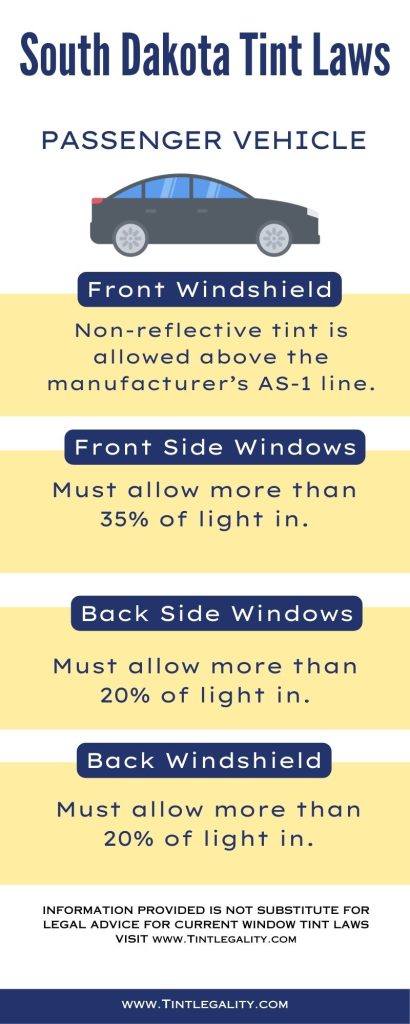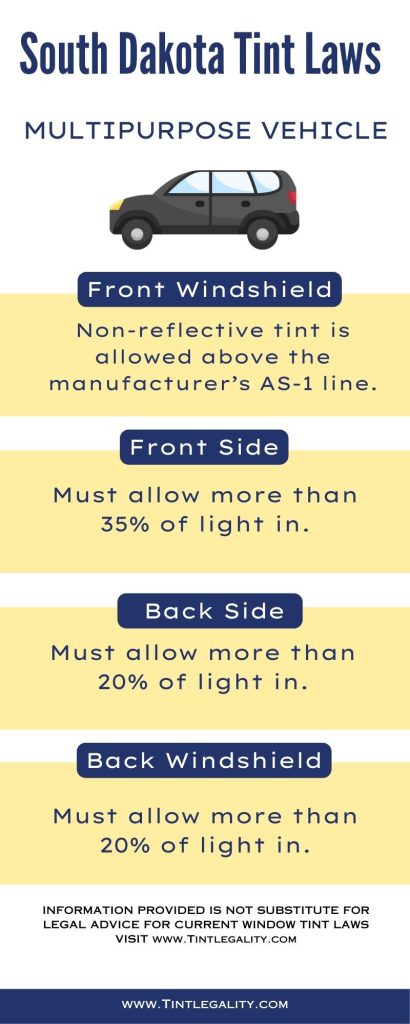South Dakota tint laws were enacted in 1989 to ensure the safety and comfort of motorists.
These rules pertain to the percentage of light permitted through the car windows, including the windshield, front and back side windows, and the rear window.
They also cover additional regulations such as reflection, medical exemptions, color restrictions, and penalties for non-compliance.
Regulations Regarding Window Tint in South Dakota
Understanding the precise regulations can be helpful to any car owner considering window tinting in South Dakota.
| Window | Light Transmission |
|---|---|
| Windshield | Non-reflective tint above the manufacturer’s AS-1 line |
| Front Side Windows | Must allow more than 35% of light in |
| Back Side Windows | Must allow more than 20% of light in |
| Rear Window | Must allow more than 20% of light in |
| Reflection | Windows should not be metallic or mirrored |
| Medical Exemptions | Permitted for certain conditions |
| Color Restrictions | No color restrictions |
Windshield
In South Dakota, non-reflective tint is allowed along the top of the windshield above the manufacturer’s AS-1 line.
This particular tint placement helps to minimize glare while not interfering with the driver’s forward visibility.
Front Side Windows
Tinting on front side windows must allow at least 35% of light to pass through.
This rule is in place to ensure that drivers have a clear view of their surroundings and other vehicles while driving.
Back Side Windows
The law in South Dakota states that the back side windows of vehicles must permit at least 20% of light to pass through.
This regulation is designed to maintain visibility for drivers and their surrounding traffic.
Rear Window
As with the back side windows, the rear window of vehicles must also allow at least 20% of light to come through. This is essential for maintaining visibility for the rearview mirror.


Additional Regulations
Aside from the rules about the darkness and reflection of window tint, South Dakota has a few more regulations that drivers need to know.
Reflection
While window tints can reflect incoming light to reduce glare and heat, South Dakota law limits the reflective quality of window tints.
Front side and back side windows should not have a metallic or mirrored appearance.
Medical Exemptions
For drivers with specific medical conditions, exceptions to the window tint laws are permitted.
Such conditions may include photosensitivity or other light-sensitive illnesses.
Color Restrictions
Interestingly, South Dakota is one of the few states that does not have restrictions on tint colors.
Therefore, drivers are free to select tint colors that best suit their personal preferences.
Side Mirrors
While South Dakota does not have specific restrictions on tinted side mirrors, it’s crucial to ensure that visibility isn’t compromised for safety purposes.
Exceptions to Legal Limits
In South Dakota, certain vehicles such as SUVs and vans have exceptions to the legal limits on window tinting. For these vehicles, the law allows the same level of tint darkness as sedans.
Penalties for Breaking the Law
Non-compliance with South Dakota’s window tint laws can result in several penalties. These penalties vary based on the frequency of violations.
Fines
First Conviction
Upon the first conviction, a violator is guilty of a class 2 misdemeanor. The fine for a class 2 misdemeanor can be up to $500.
Second Conviction
A second conviction within a year of the first can result in an increased fine. The offender may have to pay up to $1,000.
Third Conviction
A third violation within two years is also a class 2 misdemeanor, and the fine can again reach up to $1,000.
Other Penalties
Apart from fines, non-compliance with window tint laws may also lead to other penalties.
For instance, repeat offenders may be required to remove the window tint from their vehicle entirely.
Remember, the tinting laws in South Dakota may be interpreted differently by county and place of residence.
It’s always recommended to double-check this information with local DMV or law enforcement authorities.
Following the South Dakota Tint Laws not only helps maintain your vehicle’s compliance with state regulations but also ensures a safer driving experience.
References: